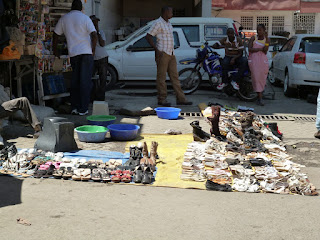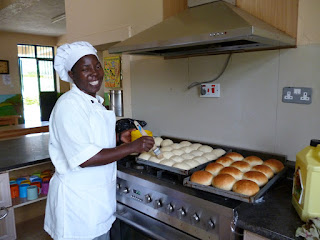My last few days have been very quiet.
On Monday afternoon, a group of Australians who form Kenyan Health arrived back from a visit up north to Loyangalani area on Lake Turkana. Only 700km but 2 days drive as the roads are so bad.
The group when they arrived unpacking. The truck was hired from Nairobi for the trip.
The group held clinics in the community. This would be a fabulous trip, reminding me of the remote places I have visited in WA and NT. Rugged ranges, treeless plains, getting bogged in sand and experiencing oasis in the midst of a desolate terrain. I am sure the locals would have been so appreciative of the team's effort, visiting such a remote place.
KENANA KNITTERS @Njoro
Wednesday I accompanied the group to visit this facility where women knit items from spun wool.
Quirky animals, shawls , rugs, pillow covers are all for sale.
On a tour through the place it was interesting to learn that they had lost customers due to a variety of reasons that were being addressed to re establish markets.
Poor quality wool, spinning process, and workmanship were all being addressed.
The wool, certified organic, is of a poor quality available nearby so it is being sourced further afield.
They need a finer micron to make the items softer and more evenly spun, as well as further training and experience for the women.
The women who are employed by Kenana are given patterns in the form of a graph as most are illiterate. With some basic knowledge of how a graph works and the symbols used a garment or toy is created. The woollen yarn is weighted out and given with the pattern, they return with the finished knitting. In the case of a toy all the finishing is completed at the centre. The soft toy fill is expensive to source and from experience of management, if the filling is given to use at home , grass has been found when inspected at customs for export. We all know how fussy they are at Australian borders with grass, seeds and bugs. More can be learnt from visiting , www.kenanaknitters.com . No photos allowed were allowed , sorry.
Dyes used are organic and natural, a green leaf(name evades me), beetroot and dahlia. Salt is mixed as a mordant when a different colour is required.
This is a field of dahlia nearby that is used in the processing.
By now most of you are aware of my interest with epiphyliums. This rather large example was found under the trees near the facility. The plant would have covered about 15 sq m. and I found this recently spent flower.
I do not think I will live long enough for my recently struck cutting, similar to this, to grow to this size.
Njoro is the village where the Knitters have set up. Rural in nature and spread out.
Typical street scenes in Njoro.
Maize is being dried in the sun, on pieces of poly tarp. Drying is necessary to reduce the moisture content for when it is milled. Ugali is a dish made from maize. a staple in the diet like we have potato, rice, or pasta. It never ceases to amaze me how much of this the children can eat.
Today as it happens Ugali has been prepared. The accompaniment is a mixture of spinach, carrot, tomato, onion and coriander. Damaries insisted I try after I told her it smelt delicious. Yes, tasted as good.
This is the dining area for the children in Mission 1. Lunch appears to be the main meal of the day. Hygiene is an obvious consideration where the children wash hands before taking the meal, all very orderly. Especially important as this meal is eaten with the fingers. Take a small piece of ugali, press the thumb into it to make a depression, fill with the greens, roll up and then eat.........one handed.

Washing.......as with any small children in a family the washing of clothes etc is never ending. Here the lines are full with nappies, clothes and the socks laying out on the stones to dry. The lines are full and the stone area most days. The building to the left of the water tower is the outside kitchen. Here the cooking is carried out over solid fuel fire(wood). There are huge tubs lowered into holes in the top of the stove and the fire is then all around. Cooking of bean stews, ugali, soups etc are prepared here. Two people are required to lift the pots, especially when full. They are transferred to the inside kitchen for serving.
Until next time.....byeeee



































